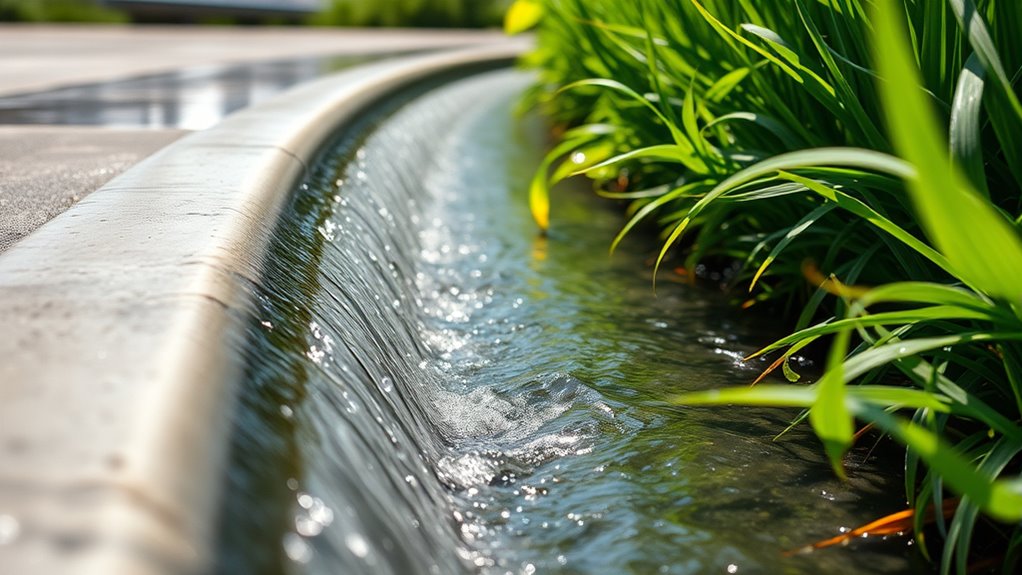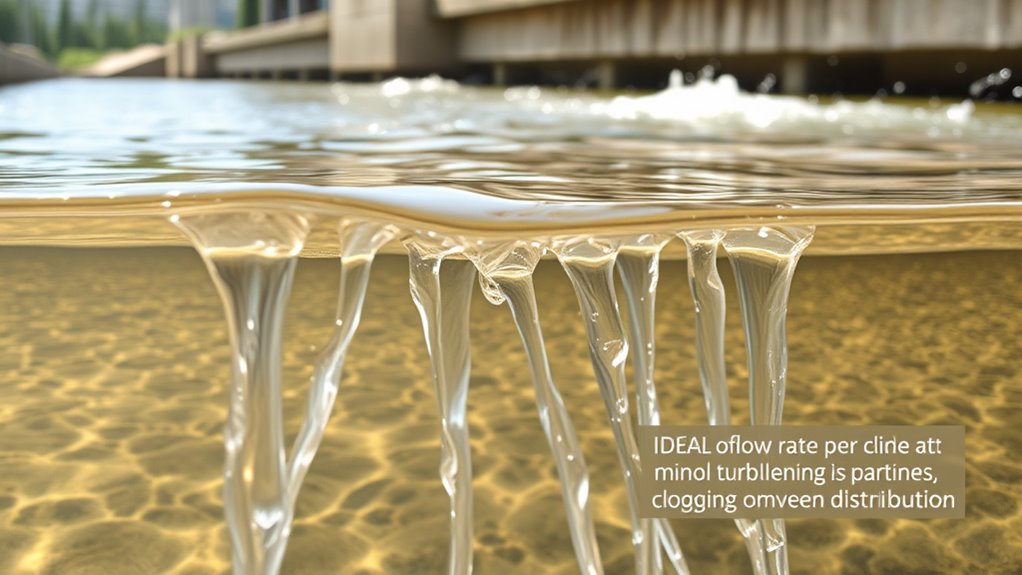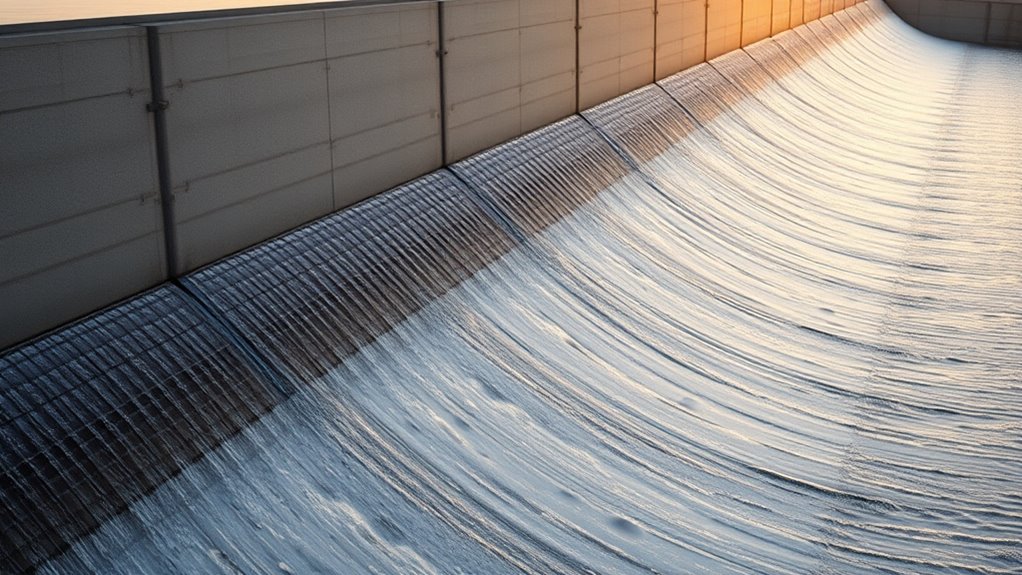Understanding sheet flow is essential for managing surface runoff during light to moderate rainfall. The ideal overflow rate per linear foot depends on factors like surface slope, roughness, and rainfall intensity. Generally, steeper slopes require higher flow capacities to prevent pooling or erosion. Precise calculations consider these elements to avoid overflow failures. To optimize design and guarantee safe drainage, exploring the principles behind sheet flow and how to determine these rates can provide valuable insights.
Key Takeaways
- Ideal overflow rates depend on surface slope, roughness, and flow velocity to ensure efficient sheet flow without erosion.
- Calculations often use empirical formulas like Manning’s equation, adjusted for flow per linear foot.
- Steeper slopes require higher overflow rates to accommodate increased flow velocity.
- Proper measurement of surface characteristics and flow conditions is essential for accurate overflow rate determination.
- Maintaining uniform surface grading and clearing obstructions optimizes sheet flow and overflow efficiency.
Understanding Sheet Flow and Its Significance in Hydraulic Engineering

Sheet flow occurs when water moves over a surface in a thin, uniform layer, typically during light to moderate rainfall or over smooth terrain. As a hydraulic engineer, understanding this flow type helps you predict runoff patterns and design effective drainage systems. Sheet flow often acts as the initial stage of surface runoff, spreading water evenly across surfaces before concentrating into channels or streams. Recognizing when and where sheet flow occurs allows you to assess potential erosion risks, manage flood hazards, and optimize land use planning. Its significance lies in its role in hydrological modeling, helping you develop infrastructure that efficiently directs excess water while minimizing environmental impact. Mastering sheet flow principles is essential for creating resilient, sustainable water management solutions.
Factors Influencing Overflow Rates in Water Management Systems

Several key factors directly impact overflow rates in water management systems, influencing how efficiently excess water is conveyed or stored. First, the slope or gradient of the surface affects flow speed—steeper slopes increase velocity, raising overflow capacity. Second, surface roughness plays a role; rougher surfaces slow water movement, reducing overflow rates, while smoother surfaces promote faster flow. Third, the volume and intensity of inflow matter—higher flow rates demand higher overflow capacities. Additionally, the design and dimensions of channels or spillways influence how much water can pass through per linear foot. Environmental conditions like debris buildup or sedimentation can obstruct flow, decreasing overflow efficiency. Moreover, integrating data-driven strategies into system design can optimize overflow performance and prevent failures. Understanding these factors allows you to optimize system design, ensuring reliable overflow management and preventing flooding or waterlogging.
Theoretical Foundations of Sheet Flow Dynamics

Understanding the fundamental principles behind how water flows across surfaces provides insight into optimizing overflow management systems. Sheet flow occurs when water moves uniformly in a thin, continuous layer over a surface, driven by gravity and surface slope. The flow’s velocity depends on factors like surface roughness, slope angle, and water depth. The physics governing sheet flow involve fluid dynamics equations, such as the shallow water equations, which describe how water accelerates or decelerates based on surface conditions. Recognizing the relationship between flow rate, velocity, and surface characteristics helps you predict flow behavior. This understanding forms the basis for designing effective overflow systems, ensuring water spreads evenly across surfaces without causing erosion or pooling. Incorporating automation techniques can further optimize flow control and system responsiveness. Mastering these principles allows you to optimize flow management and prevent system failures.
Calculating Ideal Overflow Rates per Linear Foot

To determine the ideal overflow rates per linear foot, you need to take into account factors like flow velocity and surface slope. Measurement techniques, such as flow meters or visual observations, help guarantee accuracy. Understanding these points allows you to set recommended flow rates that optimize sheet flow performance. Additionally, applying knowledge of skin care ingredients can enhance the effectiveness of treatments like eye patches for better skin health.
Factors Influencing Overflow
Have you ever wondered how to determine the ideal overflow rate per linear foot for sheet flow? Several factors influence this rate. The slope of the surface is critical; a steeper slope increases flow velocity, requiring a higher overflow rate. Surface roughness also matters—rougher surfaces slow flow, lowering the needed overflow. The type of soil or material impacts infiltration rates, affecting how much water can flow without pooling. Additionally, the volume and intensity of rainfall determine how much water needs to be managed. Vegetation presence can either impede or facilitate flow, depending on density and type. Lastly, the width and length of the flow path influence the capacity, as longer or wider areas might require adjustments to overflow rates to prevent erosion or flooding. Understanding the infiltration rates of different materials helps optimize overflow management strategies.
Measurement Techniques Used
Measuring the ideal overflow rate per linear foot involves a combination of practical methods and calculations to guarantee efficient sheet flow management. First, you observe the flow in real conditions, noting how water moves along the surface. Second, you measure the flow velocity using devices like flow meters or float methods to determine speed. Third, you calculate the flow rate by multiplying the velocity by the cross-sectional area of the flow path. Imagine watching a stream: you note how fast water travels, then measure its width and depth at various points. These measurements help you derive the flow rate per linear foot. Additionally, understanding the characteristics of the surface material can influence flow behavior and efficiency. By combining observational data with precise calculations, you ascertain your sheet flow remains consistent and efficient.
Recommended Flow Rates
What flow rate guarantees ideal sheet flow without causing erosion or pooling? For most surfaces, maintaining an overflow rate between 0.1 and 0.3 gallons per foot per minute ensures smooth flow. Exceeding this range risks erosion, while lower rates may cause pooling. Use the table below to determine appropriate flow rates based on surface type:
| Surface Type | Recommended Overflow Rate (GPM/ft) |
|---|---|
| Smooth concrete | 0.15 |
| Gravel surfaces | 0.20 |
| Sloped turf | 0.25 |
| Dense vegetation | 0.30 |
Adjust these rates based on slope, surface condition, and rainfall intensity to maintain efficient, erosion-free sheet flow.
Practical Methods for Determining Overflow Capacity

To accurately establish overflow capacity, you can use field measurement techniques, empirical calculations, or hydraulic modeling tools. Each method offers different advantages depending on your project’s scale and precision needs. Understanding how to apply these practical approaches helps ensure reliable and effective overflow management. Additionally, zoning laws may influence the selection of appropriate sites and methods for overflow assessment.
Field Measurement Techniques
Field measurement techniques are essential for accurately determining overflow capacity in sheet flow conditions. To get reliable data, you can:
- Use a flow meter along the runoff path to record flow rates directly, visualizing water moving at a steady pace.
- Place a series of marked boards or stakes perpendicular to the flow, measuring water height and spread across the surface during runoff events.
- Install temporary weirs or flumes at key points to channel water, capturing precise discharge measurements as water passes through.
- Ensuring proper maintenance and calibration of measurement devices is crucial for obtaining accurate and consistent data.
These methods help you observe flow behavior in real time, offering tangible data. By focusing on direct measurements, you can better understand sheet flow dynamics and refine your capacity estimates for field applications.
Empirical Calculation Methods
Have you ever wondered how engineers quickly estimate overflow capacity without extensive field tests? Empirical calculation methods offer practical solutions by using simple formulas derived from observed data. You start with basic parameters like slope, surface roughness, and flow width. For example, a common approach involves applying Manning’s equation or similar empirical formulas adjusted for sheet flow conditions. These methods rely on historical measurements and experience, enabling rapid assessments. You can gather data from previous projects or local measurements and plug values into these formulas to estimate maximum overflow rates. While less precise than hydraulic models, empirical methods provide reliable, quick estimates suitable for preliminary planning, design, or troubleshooting. They’re invaluable when detailed data or advanced tools aren’t available, saving time and effort. Incorporating well-established empirical techniques can enhance the accuracy of these estimations in practical applications.
Hydraulic Modeling Tools
Hydraulic modeling tools provide a practical way to accurately determine overflow capacity by simulating flow conditions under various scenarios. These tools help you visualize how water moves across surfaces, accounting for factors like slope, surface roughness, and flow rate. With modeling software, you can:
- Input different rainfall intensities to see how quickly sheet flow develops and reaches capacity.
- Adjust surface parameters to observe changes in flow distribution and identify potential bottlenecks.
- Run multiple simulations to compare outcomes, helping you optimize overflow design and ensure safety.
Common Challenges and How to Address Them

Addressing common challenges in sheet flow science requires understanding the complexities that can disrupt smooth flow behavior. One major issue is uneven surface slopes, which cause water to pool or accelerate unevenly, reducing flow efficiency. To fix this, guarantee proper grading and surface smoothing before applying overflow rates. Another challenge is obstructions like debris or vegetation, which block flow paths and lead to localized flooding. Regular maintenance and clearing help prevent these problems. Additionally, inadequate design of overflow rates can cause either overspill or insufficient drainage, resulting in erosion or waterlogging. To prevent this, accurately calculate and test flow rates, adjusting as needed. Recognizing these challenges and implementing targeted solutions helps maintain consistent, effective sheet flow, avoiding disruptions and promoting better water management. Proper surface grading and consistent maintenance are essential for optimal flow performance.
Case Studies Demonstrating Effective Overflow Rate Design

How do effective overflow rate designs guarantee reliable sheet flow in real-world applications? They optimize performance by ensuring water moves smoothly without pooling or erosion. Take these examples:
- A hillside parking lot uses precise overflow rates to prevent runoff from damaging the pavement and surrounding landscape.
- A city’s stormwater basin employs tailored overflow designs to manage heavy rains, avoiding flooding and property damage.
- An agricultural drainage system incorporates specific overflow rates to distribute water evenly, reducing erosion and maintaining soil health.
- Incorporating essential oils that promote soil stabilization can further enhance overall sheet flow effectiveness by reducing surface runoff and soil erosion.
In each case, carefully calculated overflow rates keep water flowing uniformly, minimizing issues caused by oversaturation or stagnant pooling. This consistency ensures infrastructure longevity, protects the environment, and improves overall system reliability. Effective design makes sheet flow predictable and resilient in diverse conditions.
Tools and Software for Modeling Sheet Flow and Overflow Rates

Modern tools and software play an essential role in accurately modeling sheet flow and calculating appropriate overflow rates. These technologies allow you to simulate water movement across surfaces, helping identify potential problem areas before construction begins. Hydraulic modeling software like HEC-RAS, SWMM, and XPRAFTS provide detailed analysis of flow patterns, capacity, and overflow points. Geographic Information Systems (GIS) integrate terrain data, enabling precise mapping of flow paths and elevations. Many programs feature user-friendly interfaces and automated calculations, saving time and reducing errors. You can input various surface conditions, rainfall intensities, and slope parameters to see how they influence flow rates. These tools empower you to make informed decisions, optimize design, and ensure safety and efficiency in managing sheet flow and overflow.
Best Practices for Ensuring Safe and Efficient Water Discharge

To guarantee safe and efficient water discharge, implementing best practices is essential for minimizing flooding, erosion, and infrastructure damage. First, ensure proper surface grading to direct water flow away from vulnerable areas, creating a smooth slope that promotes steady sheet flow. Second, install erosion control measures like riprap or vegetative buffers along discharge zones to prevent soil loss and stabilize the landscape. Third, regularly maintain and inspect outflow structures, such as channels and spillways, removing debris and repairing damage promptly. These steps help maintain steady overflow rates, reduce risks, and protect infrastructure. By actively managing flow paths and implementing preventative measures, you create a safer, more sustainable system capable of handling varying water volumes efficiently.
Frequently Asked Questions
How Does Vegetation Type Affect Sheet Flow and Overflow Rates?
Vegetation type considerably influences sheet flow and overflow rates by affecting surface roughness and water absorption. If you have dense grasses or shrubs, they slow down flow and reduce overflow rates, giving water more time to infiltrate. Conversely, sparse or short vegetation offers less resistance, increasing flow speed and overflow potential. Choose vegetation wisely to manage water movement effectively, whether for erosion control or flood mitigation.
What Are the Environmental Impacts of Improper Overflow Rate Design?
If you ignore proper overflow rates, you risk turning your landscape into a muddy mess or causing erosion that’s more dramatic than a soap opera. Improper design can pollute water sources, harm aquatic life, and flood nearby areas. Basically, you’re playing with nature’s patience, and it might just retaliate with increased runoff, pollution, or habitat destruction. So, don’t be that person who underestimates the power of well-planned drainage.
Can Climate Change Alter Ideal Overflow Rate Standards?
Yes, climate change can modify ideal overflow rate standards. As temperatures rise and precipitation patterns shift, you might see increased rainfall intensity and frequency, which can overwhelm existing drainage systems. You need to adjust overflow rates accordingly to prevent flooding or erosion. Monitoring climate trends and updating standards ensures your infrastructure remains effective, protecting both environment and property from the unpredictable impacts of climate change.
How Do Sediment and Debris Influence Overflow Capacity?
Sediment and debris can substantially decrease overflow capacity by clogging or narrowing channels, which slows water flow and causes backups. As debris accumulates, it creates obstructions that make it harder for water to pass through efficiently. You should regularly inspect and clear channels to prevent blockages. Maintaining clean, debris-free channels guarantees ideal overflow rates, helping to avoid flooding or overflow failures during heavy rains or increased water flows.
Are There Regulatory Guidelines for Overflow Rates in Different Regions?
Think of regulatory guidelines as the traffic lights guiding your flow. Yes, many regions have specific standards for overflow rates to prevent flooding and erosion. These vary based on local climate, soil type, and land use. You should check with regional agencies or environmental authorities for precise standards. Following these guidelines guarantees your sheet flow remains efficient and compliant, helping protect both the environment and property.
Conclusion
Now that you’ve mastered the art of calculating ideal overflow rates, remember—nothing screams “failure” like ignoring these numbers. If you think water will just magically flow without guidance, you’re in for a wet surprise. So, use your tools wisely, double-check your figures, and don’t let your engineering instincts drown in complacency. After all, in water management, the only thing worse than overflows are unprepared engineers. Stay sharp, stay dry.










